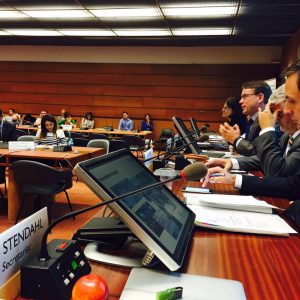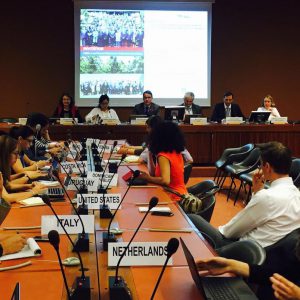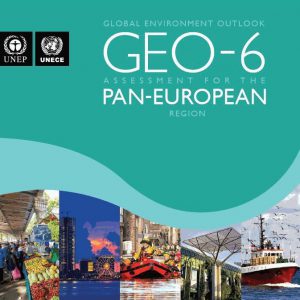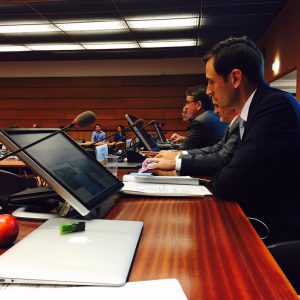Event
UNEA-2 and Batumi Ministerial Conference Debriefing

The second United Nations Environment Assembly of the United Nations Environment Programme (UNEA-2) took place from 23-27 May 2016 in Nairobi, Kenya. Over 2,500
delegates, including 123 ministerial-level participants from 174 countries met in Nairobi.
The Eighth Environment for Europe (EfE) Ministerial Conference took place in Batumi, Georgia, from 8-10 June, under the theme ‘Greener, Cleaner, Smarter!’.
An event providing an overview of the outcomes and the decisions taken at UNEA-2 and at the 8th EfE Ministerial Conference, took place at the Palais des Nations, Room XXI, on 29 June 2016.
Agenda
Welcome and Opening Remarks
Christian FRIIS BACH, Under-Secretary General and Executive Secretary, UNECE
Jan DUSIK, Director, Regional O ce for Europe, UNEP
Outcomes of UNEA-2
Jan DUSIK, Director, Regional O ce for Europe, UNEP
Jacob DUER, Principal Coordinator, Interim Sec. of the Minamata Convention & SAICM Sec.
Kerstin STENDAHL, Deputy Executive Secretary, Basel, Rotterdam & Stockholm Conv. Sec.
Q & A
Outcomes of the 8th Environment for Europe Ministerial Conference
Christian FRIIS BACH, Under-Secretary General and Executive Secretary, UNECE
Ivonne HIGUERO, Chief, Operational Activities & Review Section, Environment Div., UNECE
Tomas MARQUES, Regional SP Coordinator, Environment Under Review, UNEP
Martine ROHN, Deputy head, Int. A airs Division, Swiss Fed. O ce for the Environment
Q & A
Summary
Christian Friis Bach, Under-Secretary General and Executive Secretary of UNECE, opened the meeting, underlining important linkages between UNECE’s and UNEP’s processes and re-iterating his determination to further strengthen the partnership between the two organisations in order to deliver on the 2030 Sustainable Development Agenda. He also highlighted the importance of the current event for reflecting on how to build stronger linkages between the UNEA and the Environment for Europe processes, as well as with other UN bodies and regional fora for sustainable development.
Jan Dusik Director of UNEP’s Regional Office for Europe, agreed as to the importance of “building bridges between UNEA and EfE” and presented this event as an opportunity to gather ideas from the audience on what would be the best way forward.
Outcomes of UNEA 2
Jan Dusik proceeded with an overview of UNEA-2
- UNEA-2 had and unprecedented attendance: 2,300 delegates, 173 member states, 300 MGS, 121 ministerial-level participants. Some 24 side events and 27 Green Room events were held during UNEA-2.
- The assembly session was preceded by a Science-Policy forum and a MGS forum. A sustainable innovation expo event, and 2 symposiums with the focus of financing for the environment and migration took also place.
- The event was climate neutral and free of plastic bottles. Such measures helped avoid 15 000 tonnes of C02 equivalent.
- The UN #WildforLife campaign against illegal trade in wildlife was launched during UNEA. It helped achieve great momentum and connect everyone with issues of wildlife crime which is a global phenomenon.
- One of the biggest theme’s of the second session was delivering topics on the environment dimensions of the 2030 Agenda with the SDG (Sustainable Development Goals) as the focus. Resolutions passed provide direction of how the environmental dimension of the 2030 Agenda can be tackled. It unearthed new partnerships, tools and practical experiences of how the environment is being taken into account in national planning processes.
- The other main UNEA-2 theme was Healthy Environment, Healthy People. A thematic report on this topic was launched at the event and fed into a ministerial discussion on the subject. The paper aims to provide evidence of linkages between health and the environment and provide policy options for taking them into account (decarbonise, enhancing ecosystem resilience, and by detoxifying, decoupling and changing lifestyles). Together the members had a very rich debate, which showed joint understanding of opportunities that exist.
- UNEP’s Regional Office for Europe is now to intensify interaction with permanent missions in Geneva, as various UN member states are not represented in Nairobi. “We want to explore the setting up of a Group of Friends of UNEA in Geneva,” argued Jan Dusik.
- The third session of the UN Environment Assembly will be held on 4-6 December, he revealed and will from now on take place on odd years. In this way, the same UNEA bureau will organise and run the meetings.
On 11-20 July, the high level political forum will be held on sustainable development in New York. It will include a high-level dialogue on UNEA-2 and achievement of the Sustainable Development Goals.
UNEA-2 Committee of the Whole and Resolutions
Jacob Duer presented the activities of the Committee of the Whole, the subsidiary body of the plenary, chaired by Norway, with Iraq as rapportuer.
- 3 draft groups Botswana, Brazil, Mexico, Finland, Germany, Jordan, in which the 25 resolutions came for the adoption by the plenary, the largest amount of finalized and submitted number of resolutions ever was received.
- All resolutions are available on the UNEP web page. Currently, they are all in English, but soon will be published in other languages.
- Resolutions from the session include: investing in human capacity for sustainable development through environmental education and training, support of the Paris Agreement, sand and dust storms, and combating desertification.
- Resoltuion 2/5 “Delivering on the 2030 Agenda”: – Commits UNEA and UNEP to SDG implementation, promotion of enhanced coordination, initiating new multi-stakeholder partnerships with private sectors and CSOs, enhancing science policy interface on environment dimension on SDG’s.
- Resolution 2/6 “Supporting the Paris Agreement”: -Requests UNEP to contribute to pre-2020 efforts on climate change, including education, training, public awarenss, public participation, etc. -Strengthens support to IPCC. -Strengthens support to global climate change related assessments.
- Resolution 2/7 “Sound Management of Chemicals and Waste”: -Meeting the 2020 goal and beyond. -Sound management of chemicals and waste should be a priority in national strategies. -UNEP coordinates sound management of chemicals and waste for the achievement of SDGs. -Issue by 2017 for an overview
MEAs @ UNEA-2
Kerstin Stendahl brought upon the topic of what do UNEA resolutions mean for Basel, Rotterdam, and Stockholm conventions.
- We have moved into world of a strengthened UNEA and UNEP, we have larger opportunities to implement. More governments focus on mutually supportive nature of success of UNEA and governing conventions. This is a very good development for it emphasizes the need of nationally coordinated approaches.
- Discussions on how responsibilities would be shared under MEAs were “at times quite frought”.
- BRS roles as independent governing structures for the three conventions was confirmed.
- When it comes to chemical and waste solutions we need slots of mutual support for regional centers, as well as support for the Basel Convention. This issue of hazardous waste is real.
Gender Issues @ UNEA-2
Kerstin Stendahl also spoke about the Gender issue stating, how much there is going on in UNEP and environment groups with the gender issue.
- In a summary of the events there was a launch of gender and environment outlook. The focus: setting scene for gender and environment issues and addessing the challenges by learning from each other.
- On gender and environment: a high-level forum, a women and sustainable energy sustainable innovation expo were held.
- Women bear the disproportionate burden of environmental poverty, she explained. Women’s role as entrepreneurs is furthermore currently largely untapped but this could achieve more than one SDG in one go.
- “We need to look at gender in a holistic fashion,” Kerstin underlined.
Some remarks on UNEA-2 by Member States
- Montenegro underlined that UNEA-2’s unprecedented attendance showed that it is “a truly authoritative decision-making assembly on environmental issues”. She was pleased to note that UNEA-2 has proven to be a highly effective, results-based event which addressed practical solutions, and hopes that UNEA can “continue to be a truly influential authority for dealing with environmental issues”. She also expressed hopefulness that the scope of the discussions can be further broadened to include compliance with humanitarian law.
- Uruguay: Very pleased with the information given about involving permanent missions in Geneva, we can exchange ideas here especially those mixed with the chemical world. And pleased with resolutions made by UNEA. Thank you to all the countries involved with that.
- El Salvador: It seems as though there is a systemic issue that allows you to meet for only a few days. In this time, not everyone’s proposals will be heard, and when things slip out of hands, then it gets political. There are some countries that have more delegates and it seems as though their words get on the resolution more than others like Kenya who had just one delegate.
Outcomes of the Batumi Ministerial Conference
The 8th EfE Ministerial Conference opened on 8 June 2016, in Batumi, Georgia. The meeting convened under the theme ‘Greener, Cleaner, Smarter!’. Christian Friis Bach summarized the main outcomes of the Conference which included:
- The Environment for Europe process represents an important post-Cold War dialogue on what unites the region on the environment.
- “When it rains at a wedding it is usually a good sign,” and we hope for the same for Batumi, Christian Friis Bach quipped, referring to the weather in the Georgian city and the potential legacy for the Ministerial Conference.
- With over 700 attendants, and some 30 countries represented at ministerial level, the latest meeting of EfE in Batumi was a huge success.
- Member states drove the event’s innovative format, Mr Bach noted, before presenting achievements from the event. He mentioned the interactive panels, address by the Solar Impulse pilot Bertrand Piccard, the journalist master class, and various side-sessions on cycling, chemicals and pollutant release/transfer as well as the green economy.
- Launch of several Environmental Performance Reviews, highlighting also how member states continue to appreciate the EPR process and see it as an important instrument for the implementation of the 2030 agenda. “I hope Environmental Performance Reviews will be taken up by other regions and in collaboration with UNEP” said Christian Friis Bach.
- SEIS provides the advantage of countries not having to submit data on the environment more than once, he reminded.
- BACA (with over 80 voluntary commitments) adopted on air pollution. UNECE also administers only legally-binding initiative on topic.
- Christian Friis Bach thanked the hosting county and the Ministries involved in organisation of the meeting, noting the key role of UNEP and other international partners in making this such a productive event.
Jan Dusik, also complemented the joint work done by UNEP and UNECE for this event, and underlined that “We’d like to see how we can work on a new format of collaboration between EfE and UNEA”. He also stressed that SDG implementation was a major component of this event, providing inspiration and guidance for regional governance structures. He then presented the BIG-E video, which gave examples of concrete pledges towards the Green Economy by environmental ministers of Belarus, Sweden, Georgia and others.
Big-E
Ivonne Higuero, Chief, Operational Activities & Review Section, Environment Division, UNECE, thanked all members states and organisations for the 8th EfE meeting, highlighting especially how the partnership between UNEP and UNECE has evolved since the previous meeting in Astana. She extended particular gratitude to Switzerland for their leadership during the event, as well as to all members of the CEP Bureau, including the Chair of CEP from Astana (last EfE) meeting, which was Portugal.
- The timely adoption of the SDGs encouraged countries to make BIG-E pledges, she noted.
- Commitments will be reviewed in 2018 and indicators developed for actions. Countries can make a pledge up until 2018.
- For examples of pledges see: http://www.unep.org/roe/NewsCentre/tabid/7140/EntryId/978606/Pan-European-region-makes-high-level-commitments-towards-greening-economies.aspx
GEO-6 Launch
Tomas Marques resented process, structure and findings of GEO-6 assessment for the pan-European region.
- There are 500 000 premature deaths each year in the region from outdoor air pollution, and 100 000 from indoor air pollution.
- 275ha of arable land are lost every day in the region
- Just 7% of marine species have favourable conservation status
- 62m people lack access to sanitation in the pan-European region
- “We need to reduce resource use in the pan-European region and stabilise it
- For short paras see: http://www.unep.org/roe/NewsCentre/tabid/7140/EntryId/978605/Poor-air-quality-and-climate-change-are-the-two-greatest-threats-to-human-health-in-the-pan-European-region-says-new-UN-report.aspx
- The workplan for the global GEO-6 assessment is currently being laid out in Bangkok
Remarks by Switzerland on Batumi Ministerial Conference
Martine Rohn, Deputy head, International Affairs Division, Swiss Federal Office for the Environment, alluded to the EfE meeting in 1993, and highlighted the progress that has since been made in terms of countries’ concrete actions in view of SDG implementation.
- “I had the feeling that the EfE process is the place to be – let it continue like that” said Martine Rohn from Switzerland.
- Switzerland consulted all government departments before making its 5 BIG-E pledges, she revealed. “This homework is very good for cooperation at home”.
Final comments on Batumi Conference
The representative of Romania, also extended her gratitude for organisation of the 8th EfE, underlining the importance of continuing this cooperation via colleagues in Geneva, and also to use the Geneva hub to establish stronger synergies between UNEA and EfE processes. She also stressed the need to clearer linkages with the work of the WHO, ILO , the UNECE MEAs, as well as the BRS Conventions, Romania noted.
“There are lots of linkages between UN and other regional MEAs,” Christian Friss Bach acknowledged. “Let’s get people connected and processes connected”.
Kerstin Stendahl added that developing synergies with the BRS conventions will enable to address more concrete problems while also avoiding duplication of work and polling the ever-more scarce resources available for work in the environmental sphere.
Jan Dusik closed the meeting thanking all participants for discussions, including specifically the UNECE, member states and the GEN for supporting such side-events in Geneva.
More information and documents
Links:
UNEA-2
- UNEA Website: unep.org/unea/
- ENB Coverage: www.iisd.ca/unep/unea2/
EfE Batumi Ministerial Conference
- UNECE Green Economy Video introduction the Batumi Big-E Initiative: youtube.com/watch?v=vsksqSLTn80
- GEO-6 Report for the pan-European region (pdf)
- ENB coverage: www.iisd.ca/unece/efe8/
https://www.genevaenvironmentnetwork.org/wp-content/uploads/2020/05/invitation_29_june_2016_fs.pdf
https://www.genevaenvironmentnetwork.org/wp-content/uploads/2020/05/unea_2_outcomes_2016_final.pdf
https://www.genevaenvironmentnetwork.org/wp-content/uploads/2020/05/unea2_gender_outcomes.pdf
https://www.genevaenvironmentnetwork.org/wp-content/uploads/2020/05/unecebatumi.pdf
https://www.genevaenvironmentnetwork.org/wp-content/uploads/2020/05/debriefing.pdf





